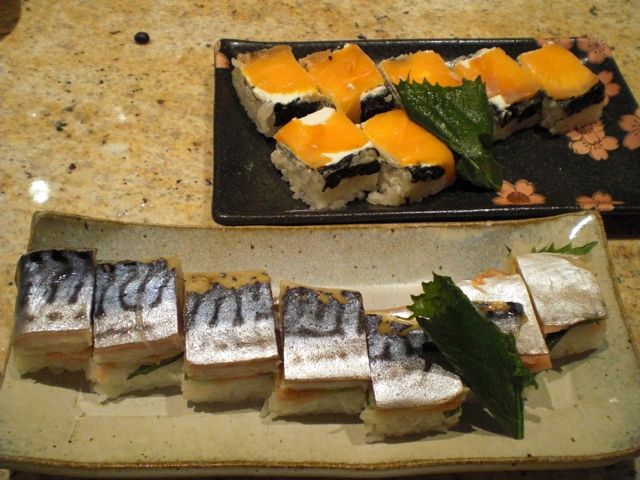The molded sushi or "
oshizushi" 押し寿司 ("oshi" means "to press or push") or sometimes called "hakozushi" 箱寿司 ("hako" means a box). As opposed to more familier "edomae sushi" 江戸前寿司 or Tokyo-style sushi, the molded sushi is easier to make as long as you have a special wooden mold. Sometime ago I saw a wooden
sushi press mold or "oshizushi hako" and bought it so I could experiment with it. In general oshizushi is not commonly available in the U.S. restaurants or sushi bars. I do have a very nostalgic memory, however, of one of the few times we had oshizushi.
Digression alert: We had recently moved to Los Angles and were looking for a new sushi bar to call home. We stopped at one "Japanese" restaurant and I started ordering several small dishes a-la-carte as we usually do, when the very bossy Kimono-clad middle-aged Japanese waitress informed us that we would be ordering one of their combination platters--no choice. A very large platter appeared featuring sashimi and other many American-style Japanese dishes (yakitori skewers, tonkatsu etc) with big slices of water melon on the side. This looked more like a American-Mexican combo-platter. As a result, we dubbed this place "Casa sushi". Needless to say, this was the first and last time we visited.
After some more, less-than-sucessful explorations, we finally found a small sushi place that became our regular.It was recommended to my wife by a carpet cleaner (an unexpected source of such information) who happened to notice Japanese artifacts in our household while cleaning the carpet and asked if that meant we liked sushi. We were astounded to learn that he was a sushi connoisseur having conducted an extensive survey of sushi restaurants in the LA basin. He pronounced this restaurant the best in the region. It turned out to be the type of restaurant where drivers of 18 wheelers fresh off the freeway parked their rigs out front, bellied up to the bar to eat sushi and discuss the finer points of raw fish with the owner chef (the LA sushi scene was quite different from what we were used to). The owner-chef of the sushi bar was from Kyushu 九州 and the young chef-de-cuisine was from Osaka 大阪. The young chef was quite creative. One evening he presented deep fried tempura sushi roll with the comment, "when it comes to food I'll try anything once." One evening he presented us with "oshizushi" (off the menu), which was from his native Osaka. Somehow that one dish particularly stuck in my mind when I thought about that restaurant or oshizushi.

Back to the sushi: I made two kinds; one is the classic of oshizushi called "
battera" バッテラ (near side in the above picture and the picture below) and the other more Western style, smoked salmon and cream cheese oshizushi (the far side of the picture above).
The non-tradtional oshizushi with smoked salmon, cream cheese and nori (the picture below) was based on my wife's suggestion (she referred to is as the Osaka version of Philadelphia roll). Actually she lined up all the necessary ingredients without my asking. So this was her creation and I just assembled it.
To make battera, I used a packaged "
shime saba" しめ鯖 which is bought frozen and vacuum packed (#1). I cannot get fresh enough mackerel to make "shime saba" myself. After thawing, I removed the transparent thin skin first (#2) and cut it lengthwise (the width has to match the size of the mold. You may have to solve some geometric puzzle to fit the fish best in the bottom of the mold with the skin side down. I layered it with thinly sliced vinegared ginger (#3) and perilla leaves (again cut into the width of the mold, #4). I then placed the
sushi rice, about even with the edge of the mold with out pressing (#5). I then pressed the rice with the top plate of the mold (#6).
To make the smoked salmon oshizushi, I placed the smoked salmon on the bottom of the mold, a thin slab of cream cheese, and a narrow sheet of nori and sushi rice.
You could make any kind of oshizushi this way. You could flavor the sushi rice by mixing chopped up perilla, pickled plum, or even aonori or "
furikake" ふりかけ. You could make two different flavored rices and assemble oshizushi with two layers of rice. The topping could be anything such as fish, meat, omelet, and vegetables like avocado, myouga, cooked shiitake etc. Actually, if you do not have or do not want to get the special mold, you could just use a plastic wrap to make a cylinder of rice (which is called "bouzushi" 棒寿司, "bou" means "log") instead making it rectangular using an oshizushi mold.
This was the ending dish of the evening. We originally tried to go to
Tako Grill for dinner but just as we were about to leave, a severe thunderstorm rolled in. We waited for a while but there was no sign of the rain letting up so we decided to stay in. Although we were eating at home our mouths were ready for the flavor of vinegared rice and this is what we came up with. We both really enjoyed these two kinds of oshizushi. Although if truth be told, I also had a hankering for "toro" and there was no substitute for that in our freezer.
In a true traditional way, battera should have been covered with thin sheet of kelp shaving called "
shiraita konbu" 白板昆布 or "baterra konbu" バッテラ昆布 but I did not have one and I have not even tried to get one. My wife suggested that it might help to make the thickness of the shime saba more even. I will try to improve next time. I have a feeling that my wife may be inspired to come up with other ideas for oshizushi--lamb sushi anyone?



